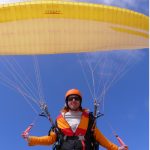How to find thermals for paragliding pilots
Looking for a system to teach our students of the cross-country paragliding courses how to find thermals, I found on the internet an interesting video from Bob Drury, who explains how to assess the potential of thermal sources using his "the 5-star system".
He evaluates five points in order to find a good thermal source.
1. Sunshine: of course, areas on the sunshine will be warmer than on the shade, so these areas are better candidates to create thermals. If the area where you are looking for a thermal is in the sunshine, give it one star.
2. Wind: meteo wind can create dynamic lift or can bring thermals up the slopes. If the area is in the wind, give it a second star.
3. Terrain: check the type of terrain and figure out if it is warm or cold; rocky areas, dry ploughed fields, villages,... all of these are warmer than green wet fields. If the terrain is good, give it another star.
4. Clouds: Cumulus clouds are formed by rising air, so if there is a cumulus cloud above the thermal source, you give it a fourth star.
5. Gliders: If you can see something climbing over the thermal source, a bird, a paraglider,... then you have your 5 stars thermal source. Go for it, no doubt!
So, as you can see, when you look for a thermal source on the ground it is basically the same way that when you are looking for a hotel in the town: 5 stars hotel are better than two stars, so if you can choose, you take the best option.
This system can help you take the right decisions quickly, to find thermals when you are flying low and to have a further cross-country flight.















